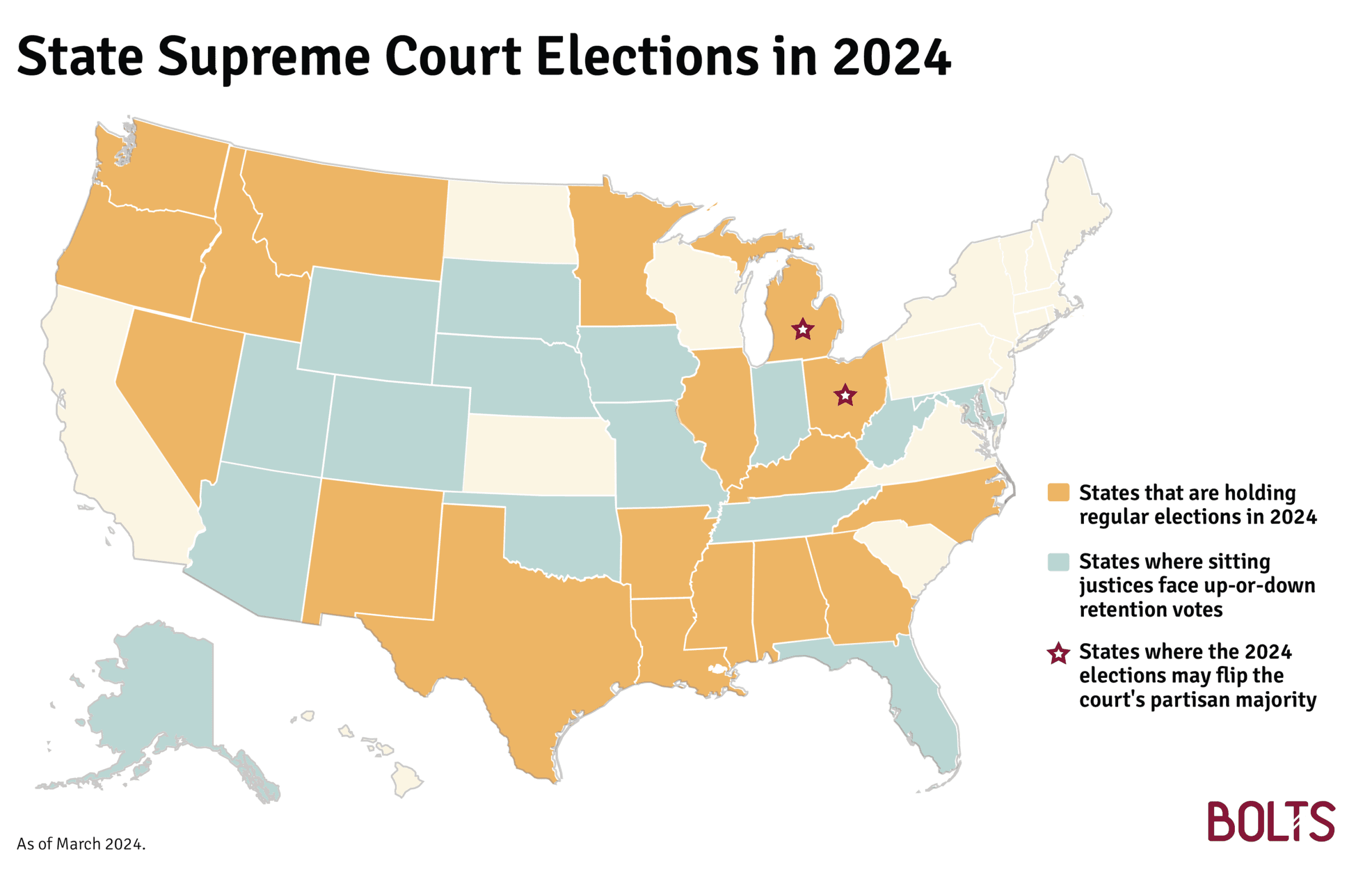Voters this year are deciding the fate of 82 seats across 33 states’ high courts. Cases involving abortion, democracy, and other critical issues hang in the balance.
Daniel Nichanian | April 3, 2024
The Texas supreme court closed out 2023 by blocking an abortion during a medical emergency, forcing a woman to flee the state. Just days before Christmas, Wisconsin justices struck down the state’s GOP-drawn gerrymanders. So far this year, Montana’s supreme court has stepped in to protect voting rights, while a decision in Alabama threatened in vitro fertilization treatments.
In each of these states, unlike at the federal level, voters chose who sits on the bench and which judges get to dictate such profound consequences. And the 2024 elections may now reshape who holds power on supreme courts across the country.
Thirty-three states have elections for their high courts this year; some have as many as five or six seats on the ballot. In total, 82 seats are up for voters to decide.
These races may potentially shift the outcome in high-stakes cases that are already in the legal pipeline on everything from the rules of direct democracy to the fate of reproductive rights.
Michigan and Ohio are the two states where a supreme court’s partisan majority could flip outright. Democrats are defending a narrow edge in Michigan; the GOP is doing the same in Ohio.
But the 2024 elections may also affect the ideological balance of other supreme courts, starting with Kentucky, Montana, North Carolina, and Texas. Some of these states hold nonpartisan races where judicial candidates are not affiliated to political parties; but those courts still tend to have liberal, moderate, and conservative wings, and parties and other groups often get involved in their elections, sometimes pouring in huge amounts of money.
Eighteen states are holding regular elections for their supreme courts, namely races where candidates can challenge incumbent judges or run for an open seat. There are 51 such elections in 2024, but importantly, about a third of them are effectively already over; in most cases, that’s because only one candidate filed to run.
The procedure is markedly different in 15 other states, where incumbent judges who want a new term run in so-called retention elections—simple up-or-down votes, with no challengers, that decide if a judge should stay in office. It is exceedingly rare for justices to be ousted in retention elections—in some states this has never happened—but some do get heated.
You can explore the rules in the state that interests you in our state-by-state guide to each court.
Note that the exact landscape of this year’s elections may still change; if a judge up for retention were to resign early, for instance, it would cancel the election altogether.
The 2024 cycle is already well underway. Three incumbents in Texas were voted out in March in the GOP primary after facing attacks by far-right politicians. An Illinois justice survived a primary. And an Arkansas justice hopped to another seat on the bench to evade retirement rules.
The stakes only escalate from here. Conservatives hope to gain ground on Montana’s liberal-leaning court thanks to the retirement of two justices long targeted by the right. In Kentucky, the retirement of a conservative-leaning justice may have the opposite effect. Democrats risk falling even further behind on North Carolina’s court, while the prospect of Michigan and Ohio’s courts flipping carries important ramifications for sentencing and democracy.
Across Arizona and Florida, four justices who voted to uphold abortion bans this month are up for retention—two in each state. Three justices who took part in the Colorado supreme court’s decision to bar Donald Trump from the ballot also face retention tests. A justice who voted against the erosion of direct democracy faces reelection in Mississippi.
Bolts today guides you through each of the 33 states with elections for their high courts.



No comments:
Post a Comment